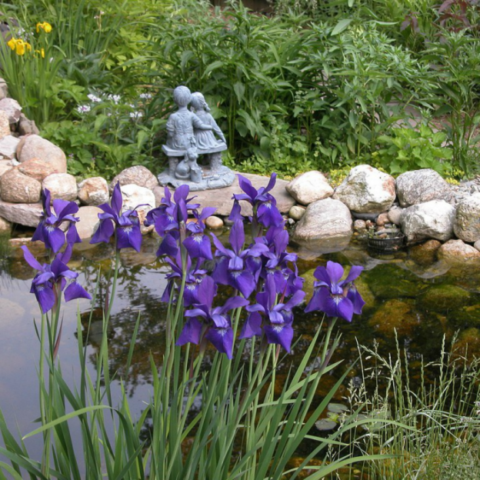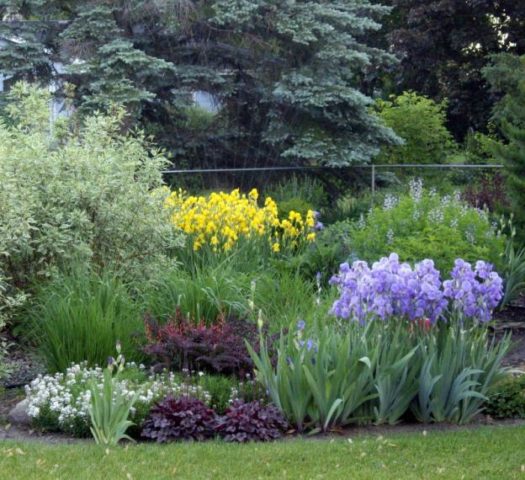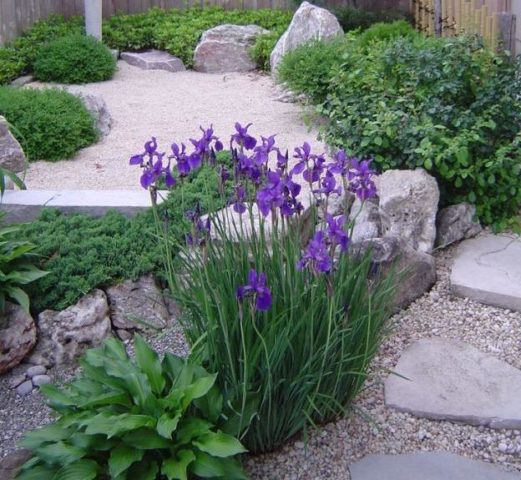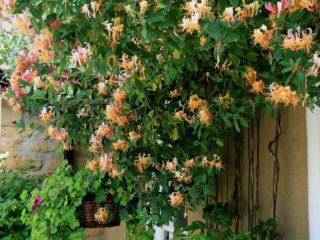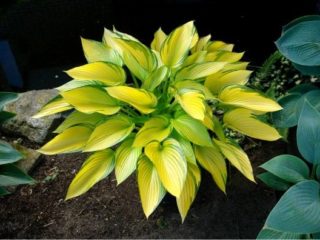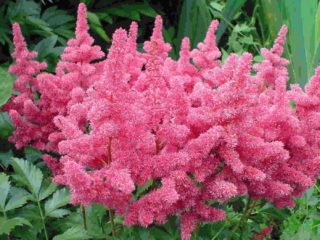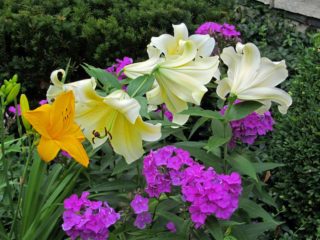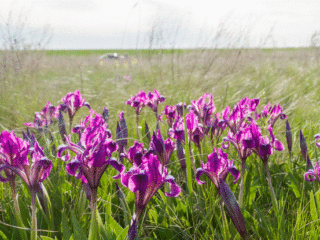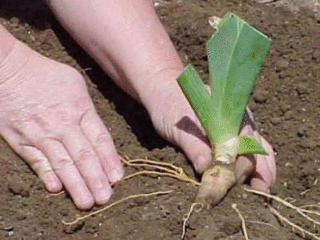Content
Irises have earned recognition from gardeners for the variety of flower colors. Hybrid forms are used in landscape design. They can be tall and dwarf, with simple or double flowers. Photos of Siberian iris and its varieties will help you decide on the choice of variety for the garden.
General description of Siberian irises
A wild species of Siberian iris (Íris sibírica) grows in the European part, Siberia and the Far East. The rather extensive distribution area is due to the plant’s frost resistance, unpretentiousness to weather conditions and soil composition.

The crop is an endangered species protected by law in Latvia, Ukraine, Belarus and Russia
Description of the Siberian iris (pictured), listed in the Red Book:
- The stems are erect, often branched, growing up to 110 cm in height.
- The leaves are narrow, linear, 80 cm long, 5 cm wide. The leaf blades are soft, dark green, with smooth edges and a pointed tip.
- The flowers are small - up to 6 cm in diameter. Located on the tops of peduncles. The bracts are drooping, in the form of an ellipse, the central petals are erect, concave towards the center.
- The color is purple or blue, with white or yellowish splashes at the base of the lower petals.
The root system is superficial, creeping, highly branched. The plant produces a lot of basal shoots. It can bloom in one area for more than 15 years.
When and how do Siberian irises bloom?
Siberian irises have small flowers, but more of them are formed than Japanese varieties. At the age of four years, the plant forms up to 35 buds. Flowering time depends on the variety, usually May-June. The buds do not bloom simultaneously; the life cycle of one specimen is 5 days. The flowering time of the Siberian iris is 15-21 days, this indicator also depends on the variety.
Distinctive features of Siberian irises
The main advantages of Siberian irises include the high frost resistance of the crop. Thanks to this quality, the plant can be grown in different climatic zones (3-9). Irises are hardy, with simple farming techniques, stress-resistant, and do not respond to temperature changes and lack of lighting.
Soil with a reaction towards alkaline is not suitable for planting.

Wild species and hybrids based on them are characterized by high immunity
Plants are not affected by infections and garden pests.
Varieties of Siberian irises
Siberian irises include hybrid beardless varieties of Limniris. Most often the plants are tall (up to 120 cm), but there are also dwarf forms that do not grow higher than 40 cm.The petals are colored blue, blue, violet, yellow with variations in shades of red, orange or purple. The varieties retain their decorative appearance throughout the season thanks to leaves that do not change color until the onset of frost. A review of the best varieties of Siberian irises used in ornamental gardening will help you choose a crop for any region.
Harpswell Haze
Iris Harpswell Hayes is distinguished by numerous shoots with a height of 85 cm. The flowers have a diameter of 13 cm, which is considered large for Siberian irises. The number of buds on a bush is 25-30 pcs. The bracts are blue with purple veins and a contrasting yellowish-brown fragment near the core. The styles (branches of the pistil) are light blue. Flowering period is the second half of June.
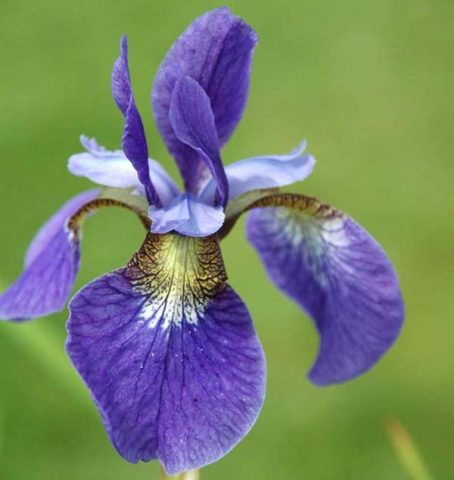
Harpswell Hayes is used in floristry
The Snow Queen
The variety of Siberian irises Snow Queen or Snow Queen is distinguished by a color that is rare for a culture. The flowers are simple, 10 cm in diameter. The petals are white with a lemon-colored core. The leaves are thin, curved, bright green, the stems reach a height of 90 cm. The Siberian iris blooms in July, the cycle lasts 21 days.
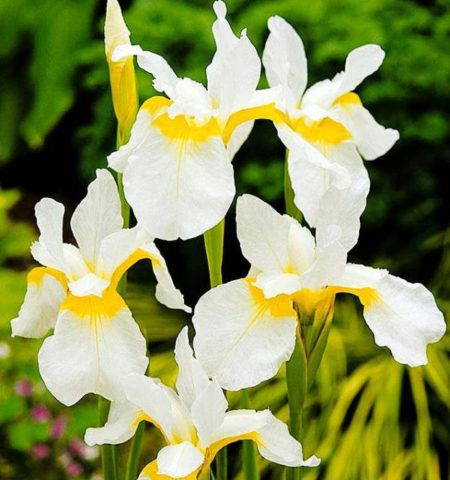
The Snow Queen is a variety with multiple buds; an adult plant can have up to 50 of them.
White Swirl
Siberian iris White Swirl (white swirl) is a tall, compact, dense herbaceous shrub up to 1 m high. The flowers are simple, open, ivory-colored with a yellow fragment at the base. The petals are round, slightly corrugated, and of the same size. Grown in open ground for area decoration and cutting.
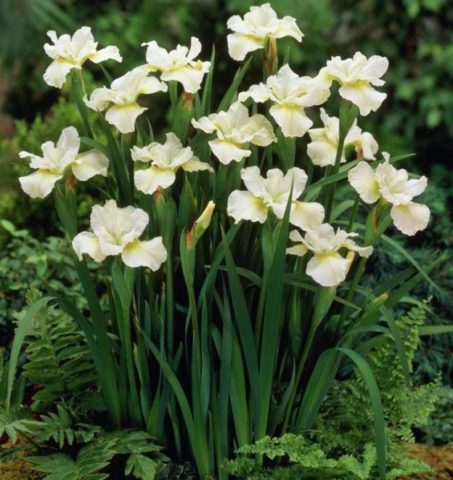
The White Swirl flowering period begins in mid-May.
Representatives of this variety look like daffodil bushes.
Ruffled Plus
The hybrid Ruffled Plus (ruffled) is part of the group of double varieties of Siberian irises. This is a medium-sized compact bush, 65-70 cm high, 40 cm wide, with long, narrow, bright green leaves. The lower petals are rounded, the inner ones are oblong, with wavy edges. The color is lavender with purple veins and a white core.
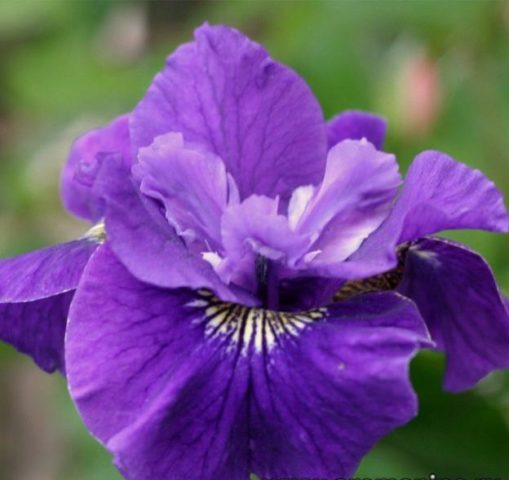
Ruffled Plus blooms abundantly, long-lasting, beginning in May-June
Leader of Altai
Hybrid of Russian selection, one of the frost-resistant representatives. Siberian iris Leader of Altai is the most common plant in temperate climate gardens, its description is as follows:
- height – 80-95 cm, width – 50 cm;
- leaves are xiphoid, narrow, 70 cm long, light green;
- bracts dark blue with a white border along the edge and a yellow fragment at the base;
- petals are blue with a purple tint.
The variety is classified as terry varieties.

Up to three buds bloom simultaneously on one peduncle
Barcelona
The variety of Siberian irises Barcelona (Barselona) is a rather rare two-color hybrid. It is distinguished by its exotic flower shape and color. The stipules are strongly lowered and everted, colored burgundy with an orange tint and white stripes at the base. The styles are long, erect, bright yellow with wavy edges.

Iris Barcelona has large, glossy leaves with a bluish tinge, which turn brown in autumn.
Hubbard
The Siberian iris variety Hubbard is characterized by simple, large flowers with a diameter of 17 cm. The tall plant reaches up to 120 cm. The flowers are violet, closer to purple. The bracts have a pattern of blue, white and yellow. The leaves are narrow, long, soft, light green.
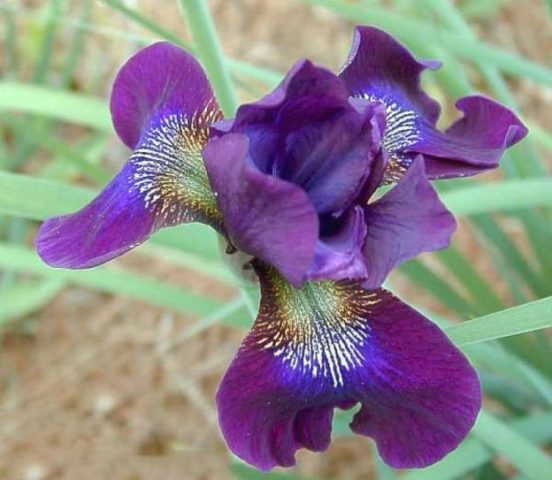
The Hubbard variety of irises has the longest flowering period, lasting from mid-May to July.
Rosie Bows
The hybrid form of Siberian irises Rosy Bows (pink bows) is one of the decorative representatives of the terry group. The culture of Dutch selection is distinguished by late flowering - June-August. The plant is medium-sized (80 cm in height), compact, with abundant formation of buds. Rosie Bows is classified as an elite variety.
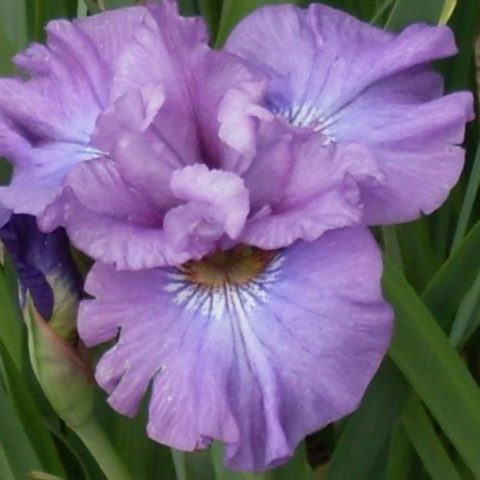
The color of the petals can be light lavender, blue, but there are representatives with dark pink flowers
Hohenflug
The remontant variety of Siberian irises Hohenflug (high flying) is one of the tallest varieties. A dense, spreading bush reaches a height of 160 cm. It is rarely found on sale, it is expensive, but it also blooms 2 times per season - in June and August. A plant with short leaves located at the base of the bush. The flowers of Siberian irises are purple with white stripes at the base, simple.
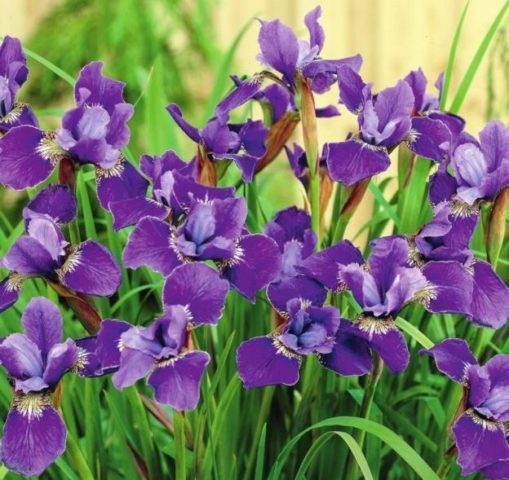
More often they grow crops for making bouquets
Concord Crash
The double hybrid Concord Crush produces flowers of a rich dark blue color, the petals with a brown area at the base take on an inky hue in the sun. The crop is medium-sized (up to 60 cm), width – 30 cm. Flowering begins in May and lasts 20 days.
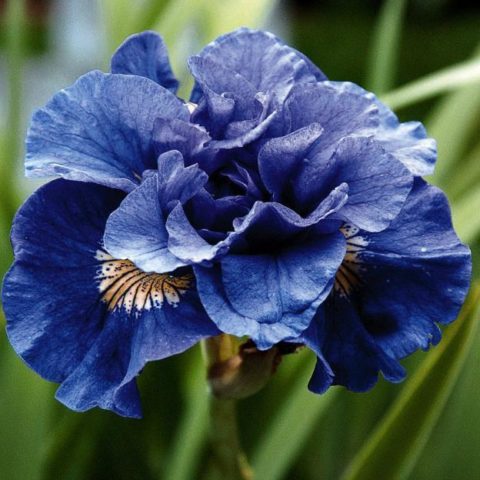
The plant is light-loving; when grown in the shade, it loses its decorative effect.
Alba
A representative of the Siberian aeroid irises, Alba (Japonese Alba) reaches a height of about 80 cm. The flowers are small, their diameter does not exceed 8 cm. The bush is very dense with intense stem formation and abundant flowering, beginning in July and lasting three weeks. The petals are white with yellow fragments at the base.
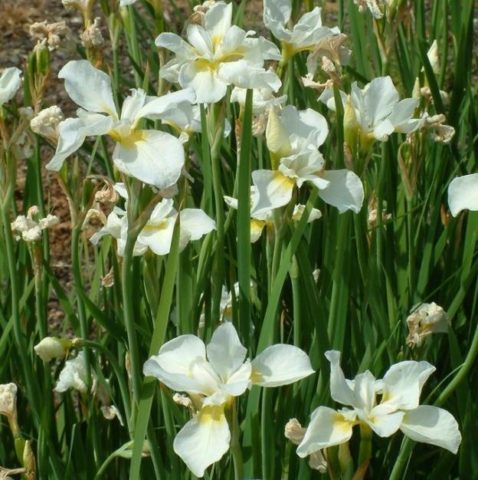
In the landscape, Alba is used to decorate the banks of reservoirs
When air humidity is low, the flowers dry out and fall off.
Pink Parfait
A hybrid with double flowers, Pink Parfait is a medium-sized herbaceous shrub, reaching 70-80 cm in height. The flowers are soft pink in color, with numerous petals. The bracts are rounded with an orange spot at the base, wavy edges and thin purple veins.
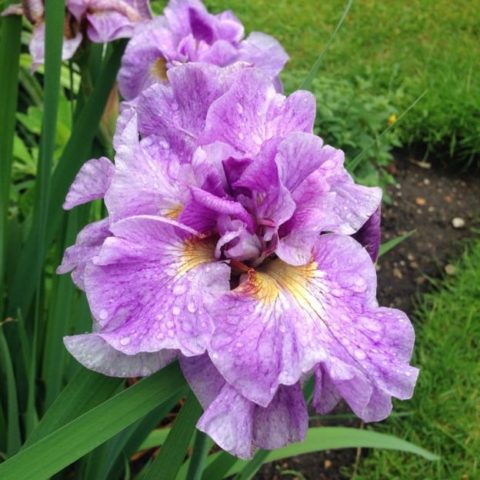
The flowering period of Pink Parfate is May-June
Butter
A hybrid variety of Siberian irises from the Dutch selection Butter and Sugar is characterized by different flower colors. The bracts are light yellow with a green splash at the base, the styles are white, long, open. Flower diameter – 10 cm. Plant height – 70 cm. Flowering time – mid-summer.
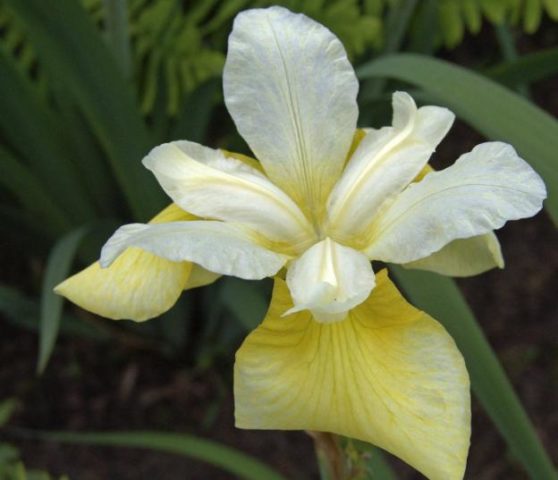
Four or more buds are formed on one Butter peduncle
Iris
The only bearded representative of Siberian irises is the dwarf Iris, the height of the bush is 45-50 cm. The flowers are large - 15 cm in diameter with burgundy bracts and light blue styles. Flowering time is May.

The Kasatik variety is used in design to create borders and decorate rock gardens
Black Joker
Hybrid Black Joker (black joker) is distinguished by the exotic color of its flowers. The foils are dark purple with a golden border along the edges and yellow stripes at the base, the petals are lavender with veins, the styles are dark blue. The bush is low - 50-60 cm, compact. There are 4 buds on the peduncle.
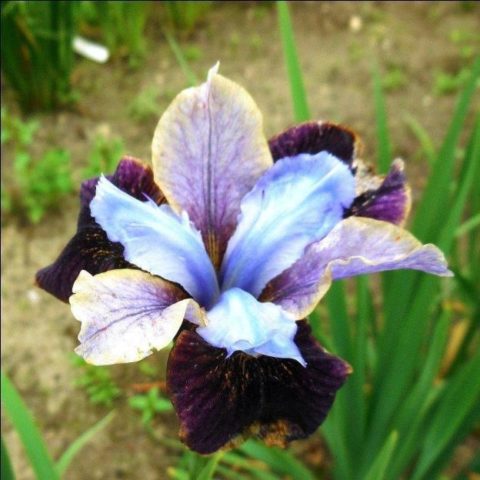
Flowering of Black Joker begins in June and lasts 20 days
Blue King
The Blue King variety of Siberian irises has bright blue flowers. Their diameter does not exceed 15 cm. The fouls are long, rounded, with a tiger pattern near the core. The central petals are formed in the form of an ellipse with wavy edges, erect. Plant height is 1.3-1.5 m, the leaves are narrow, long, hard, dark green in color.

Blue King blooms for two weeks in July
Swan in Flight
Swan in Flight (swan in flight) is a hybrid of Siberian irises with large simple flowers. The petals are open, white with a yellow or green fragment near the core. The bush reaches 70 cm in height. It is very compact but produces many stems. Blooms in June.

Swan in Flight is suitable for design, but the variety has found its main use in floristry
Cassandra
Cassandra is a dwarf representative of Siberian irises. Blooms in May. The bush is densely leafy, the leaf blades are narrow, much longer than the peduncles. Stems do not grow higher than 70 cm. The flowers are simple, open, with rounded petals of light blue color and an orange splash at the base. Diameter – 10-15 cm, single location on the peduncle.
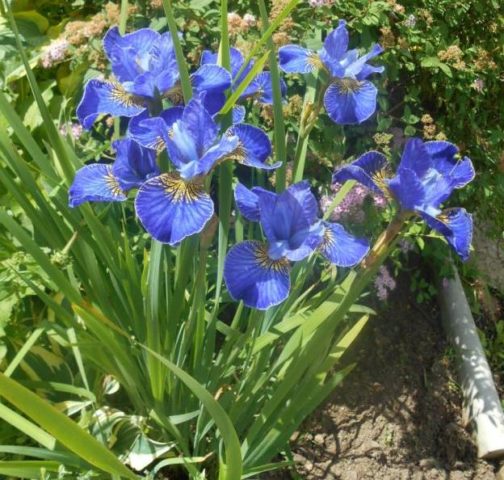
The Kassandra variety is drought-resistant, but demanding of lighting
Big Ben
The bush is medium-sized, dense, compact, reaching a height of 80 cm. The Big Ben variety is one of the profusely flowering representatives of Siberian irises. The color is deep purple with white fragments on the bracts. The diameter of the flowers is 7 cm. Flowering in June.

Big Ben is the most common variety in the gardens of the Central regions
Siberian iris in landscape design
The culture is widely used in ornamental gardening. The plant combines with any type of conifers, ornamental shrubs, and flowering flora.
After the flowering period, the stems are cut off. Bushes with dense long foliage add decorativeness to the landscape. A popular decoration technique is the creation of iridariums, flower beds in an urban area or on a personal plot, planted with different varieties of plants.
Several solutions on how you can use Siberian irises in garden design:
- Planted to delimit landscape zones.
- The banks of artificial reservoirs are decorated.
- Included in mixborders with ornamental plants.
- Placed on the sides of the garden path.
- Decorating rock gardens.
- For edging the lawn.
- Rock gardens are decorated.
- In mass planting to fill empty territory.
Conclusion
Photos of Siberian iris, its use in the landscape, characteristics and descriptions of popular hybrids will help to get a general idea of the variety of varieties. The priority when choosing a crop will be its high frost resistance, simple agricultural technology, and stable immunity to diseases and pests.

